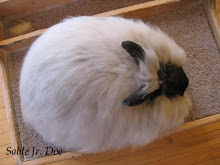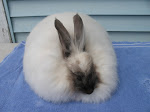I took a piece of paper and drew two columns (entitled DOES and BUCKS) and listed every member of my base herd on one side or the other. FYI, a 'Base herd' is composed of all the rabbits that make up the core of your rabbitry--those who are proven to be the best woolers, show animals, breeders, producers, etc. Your base herd is the source of the best stock your rabbitry is able to produce, and consists of the most valuable animals you have.
After listing each member of my base herd, I went ahead and listed the positive and negative traits of each rabbit. For ex. my NZ/FA cross doe Spang's Yvonne was listed this way:
Yvonne:
+hardy
+good type
+good bone
+no woolblock
-poor wool
You could get much more detailed than this if necessary. Instead of simply writing 'good type' you could list exactly which parts of the type are good, such as good shoulders, good depth, etc. If you were planning breedings based strictly on type (if you were working on one specific trait in this breeding cycle), then this information would come in handy to know which strengths to combine with what flaws. For my purposes this week I only wanted an overview, so further detail was not necessary.
'-Poor Wool' in Yvonne's case referred to the quality of her Senior coat, which is uneven in length, non-synchronized, and uneven in texture. The only time I might pair this rabbit with another of poor wool quality is if I wanted to set a particular type trait as much as possible. Otherwise, I would choose a buck with excellent wool to complement her so that at least a portion of the resulting litter would contain both traits. It is important to note that good wool is much easier to set than good type, so a 'poor wool/poor wool' combination might not be out of the question if both parents were capable of producing typey babies. It all has to do with what your goals are at the time.
The overall categories I included for the rabbits in my herd are as follows, but there are many traits that others would find important in their herds or that they want to strive for in the future:
Good Wool
Good Type
No tendency to Woolblock (no woolblock)
Hardy
Good bone
Poor type
Medium type
Good eater
Good drinker
Good color
Poor color
Non-synchronized coat
Even growth
These categories may seem a little haphazard, but they fit with what I am working toward at the moment and I know what they all mean in reference to my rabbits. Other breeders will have different categories and sub-categories, but the standards in angoras typically revolve around type and wool.
'Hardy' refers to a rabbit's overall thriftiness or 'toughness'. In other words, it measures their ability to stay consistent in eating/drinking/wool growth/ and maintain good health. They are the most reliable rabbits.
A 'Good Eater' description is self-explanatory (and often ties in with rabbits who are not prone to woolblock). 'Good Drinker' seems like a wierd trait but it is very important because rabbits who consume a lot of water are healthier, rarely get woolblock, and are much, much easier to condition than rabbits who do not drink as often. Even growth vs. Non-synchronized refers to coat type but may be positive or negative depending on the type of rabbit you prefer (shearing or plucking).
Looking at the traits of your rabbits on paper can make things much easier and take some of the guesswork out of choosing compatible breeding pairs. Of course, the best breeders in the rabbit world may not use any of these things, but rely instead on an instinct for identifying rabbits with potential and combining them to produce specific results. The important thing is to always keep breeding, keep checking, and keep adjusting your priorities to stay on track with the type of rabbit you are trying to produce.
Last of all it looks like I finally got some baby pics snapped! The first two below are of Margaux and her litter by Giacomo (now 5 weeks of age), and the third is of two of Natalya's babies just before weaning (now 7 weeks old).




And last of all here is just a gratuitous shot of my three sons in the Baseball Hall of Fame, which we visited last week:). It was amazing to see all the old equipment everyone used and all the old uniforms (made out of WOOL!). The boys read all about Babe Ruth and got to sit in a locker that once belonged to Hank Aaron. BIG thrills!!:-)























No comments:
Post a Comment